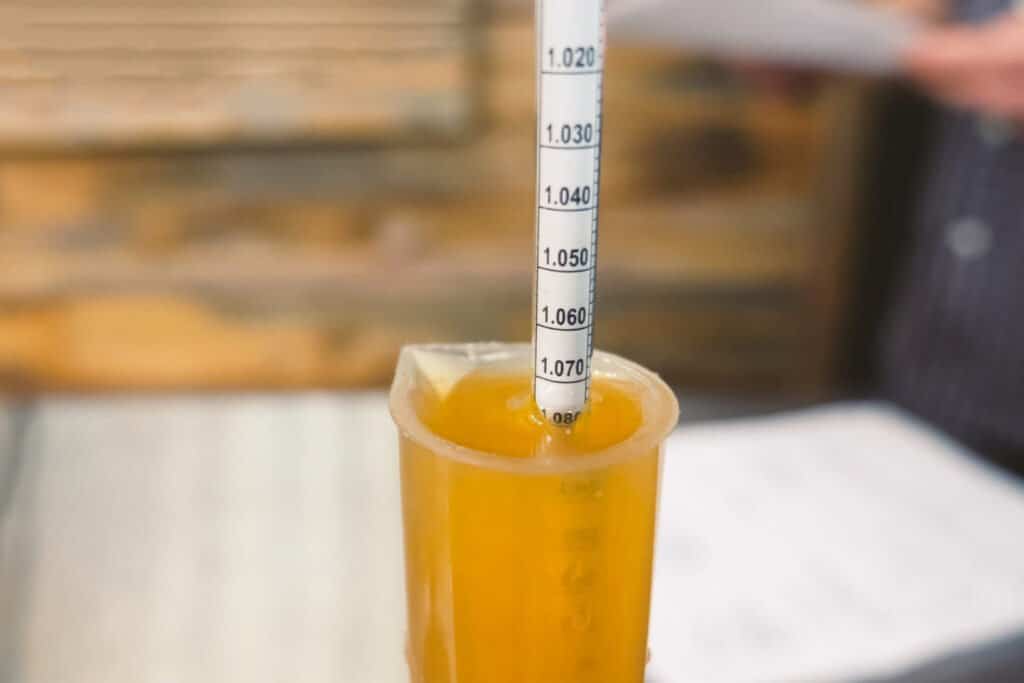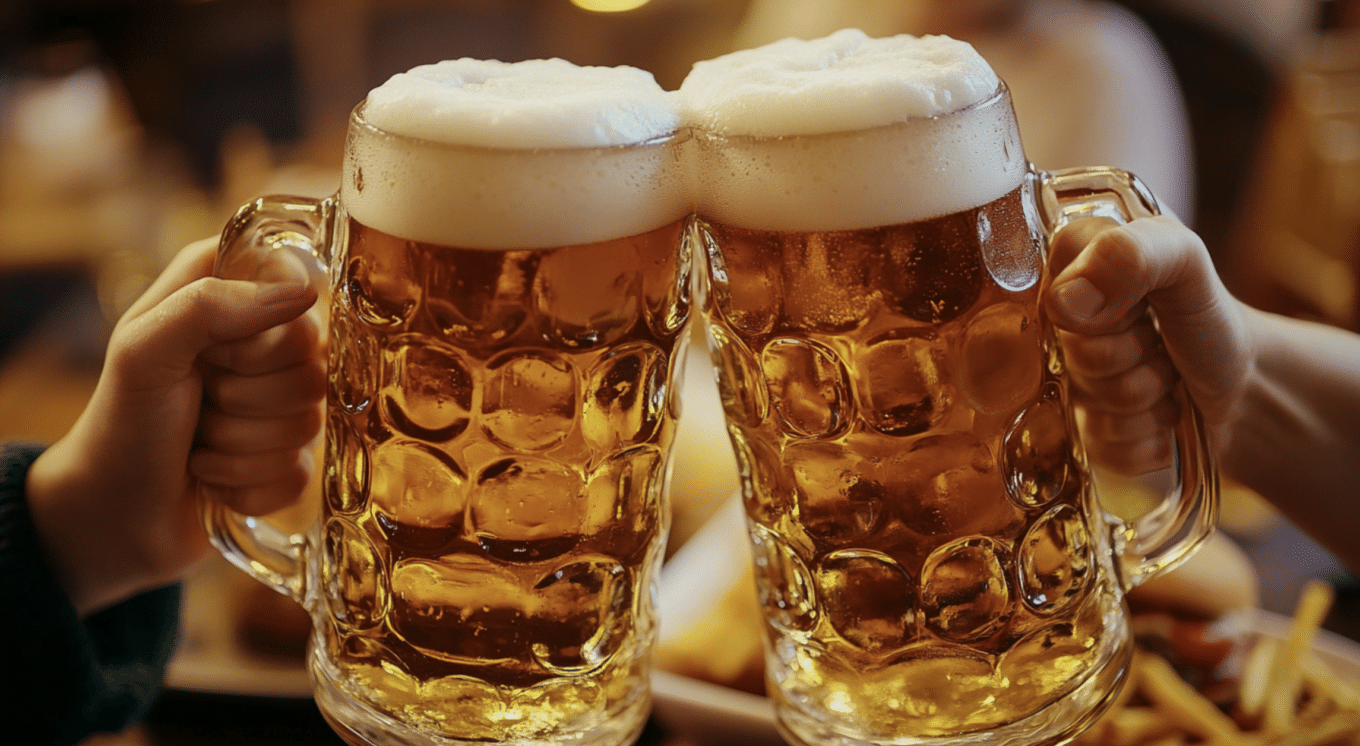Have you ever wondered how strong your homemade beer is? As a bartender or homebrewer, you’ve probably heard of ABV, but figuring it out can be tricky.
All those numbers and calculations can make your head spin faster than your latest brew.
But don’t worry! This guide will break down the ABV calculation into simple steps anyone can follow. By the end, you’ll be able to calculate the alcohol content of your drinks easily.
This post will explain the ABV basics, show you the necessary tools, and give you a step-by-step method for calculating ABV.
You’ll soon be an ABV pro, whether crafting beers at home or mixing drinks behind bars. Let’s get started!
Understanding Alcohol by Volume (ABV)
Let’s start with the basics. ABV stands for Alcohol by Volume. It’s a simple way to measure the amount of alcohol in a drink.
Think of ABV as a percentage. For example, if a beer has 5% ABV, 5% of the total volume is pure alcohol. The rest is water, flavors, and other ingredients that make the drink tasty.
Here’s a fun way to picture it: Imagine you have 100 tiny droplets of your favorite beer. In a 5% ABV beer, 5 of those droplets would be pure alcohol.
The other 95 droplets? That’s everything else that gives the beer its flavor and body.
This percentage is super helpful. It lets you know at a glance how strong a drink is.
Whether brewing at home or mixing drinks at a bar, knowing the ABV helps you create balanced, enjoyable beverages every time.
Calculating ABV: The Basics
Step 1
Measure Original Gravity (OG). Before adding yeast, Use a hydrometer to measure OG, which shows the initial sugar content.
Float the hydrometer in your wort and record the reading where the liquid meets the stem.
Step 2
Measure Final Gravity (FG). After fermentation, measure FG. This indicates the remaining sugar.
Use the same method as measuring OG but with your finished beer.
Step 3
Use the ABV Formula. Apply this formula: (OG – FG) x 131.25 = ABV%.
This formula works because 131.25 is the conversion factor between specific gravity points and alcohol percentage.
Example Calculation
Let’s walk through this step-by-step:
- OG reading: 1.050
- FG reading: 1.010
- Subtract FG from OG: 1.050 – 1.010 = 0.040
- Multiply the result by 131.25: 0.040 x 131.25 = 5.25
- Final result: 5.25% ABV
Additional Formulas and Methods
Wine: (Starting FU – Ending FU) / 7.4 = ABV%
FU stands for Fermented Units, measured in degrees Brix.
Adding Spirits
(Ounces of alcohol x alcohol’s ABV) / Total volume = New ABV%
This formula helps when adding liquor to beer or creating cocktails.
These methods allow accurate ABV calculation for different alcoholic beverages, accounting for their unique fermentation processes.
Tools for Measuring ABV

Let’s discuss the tools you’ll need to measure ABV. Don’t worry—it’s not rocket science!
1. Hydrometers
Hydrometers measure liquid density, crucial for determining sugar content before and after fermentation.
You take two readings: Original Gravity (OG) before adding yeast and Final Gravity (FG) after fermentation.
These readings are essential for calculating ABV. Hydrometers are affordable and easy to use, making them a staple in any brewer’s toolkit.
2. Refractometers
Refractometers primarily check sugar levels but also assist with ABV calculations. They’re especially useful for quick checks when working with malt extracts, as they require only a small sample.
Refractometers are more precise than hydrometers and can be used throughout brewing.
3. Precision Scales
Precision scales ensure accurate measurement of fermentable sugars. This accuracy is key to consistently achieving your target ABV across batches.
A good scale also helps measure other ingredients, ensuring overall recipe consistency.
4. Gas Chromatographs
Gas chromatographs provide highly precise alcohol readings. While not common in home brewing, they’re standard in professional setups for detailed analysis.
These machines can detect trace amounts of alcohol and other compounds in your brew.
Importance of ABV for Homebrewers and Bartenders

1. Responsible Drinking
First, ABV is key to drinking responsibly. Knowing how strong a drink is allows you to make smart choices about how much to drink.
This is useful for everyone, whether enjoying a night out or hosting a party at home.
2. Quality Control
For homebrewers, ABV is a big deal. It helps you keep your brews consistent. When you make a batch that turns out great, knowing the ABV enables you to recreate that success next time.
It’s like having a secret recipe for perfect beer every time!
3. Crafting Balanced Drinks
Bartenders, ABV is your best friend, too. It helps you craft balanced cocktails that taste just right, and it lets you guide customers to drinks that match their preferences.
You’ll know exactly what to serve, whether someone wants something light or strong.
4. Recipe Adjustment
Lastly, ABV helps you fine-tune your creations. Want to make a stronger beer or a lighter cocktail?
Understanding ABV lets you adjust your recipes to get the taste just right. It’s like having a magic wand for your drinks!
Standard ABVs of Common Drinks
| Drink Type | Typical ABV Range | Notes |
|---|---|---|
| Spirits | 40-50% | Spirits pack a punch with their high ABV. This is due to the distillation process, which concentrates the alcohol. |
| Wine | 10-15% | Wine’s ABV depends on the fermentation process and grape sugar content. Longer fermentation usually means a higher ABV. |
| Beer | 2-10% | Beer ABV varies widely. Light beers are on the lower end, while strong ales and stouts can reach higher levels. |
| Liqueurs | 15-30% | Liqueurs are spirits sweetened and flavored with fruits, herbs, or cream, resulting in a lower ABV than pure spirits. |
| Ciders | 4-6% | Ciders are similar to beer in ABV. The natural sugar in apples ferments to create this refreshing drink. |
| Mead | 8-20% | Mead, or honey wine, can vary greatly in ABV depending on the honey used and fermentation time. |
| Cocktails | Varies widely | Cocktail ABV depends on the ingredients. A Martini (30-40% ABV) is stronger than a Mojito (about 13% ABV). |
| Seltzers | 4-6% | Hard seltzers are designed to be light and refreshing, with an ABV similar to beer. |
These differences stem from ingredients, production methods, and intended use. Understanding these ranges helps in responsible drinking and mixing.
Practical Applications for Calculating ABV
For Bartenders
Knowing ABV helps create balanced cocktails. Mix strong and weak spirits to achieve the desired potency.
For example, balance a high-ABV gin with a lower-ABV vermouth in a Martini. This knowledge also aids responsible service. Inform customers about drink strengths to help them make informed choices.
Use ABV to guide patrons towards drinks that suit their preferences and tolerance.
For Homebrewers
ABV calculation is key to replicating successful recipes: record OG and FG for each batch. When you brew a great beer, these numbers help you recreate it.
To adjust alcohol levels, manipulate the amount of fermentable sugars. For a stronger beer, increase the grain bill or add brewing sugars.
For a lighter brew, reduce fermentable or increase the water content. You can fine-tune recipes to match your taste preferences or brewing goals.
Conclusion
Now you’ve got the lowdown on ABV calculation. It’s not just about numbers – crafting drinks that hit the spot every time.
For bartenders, this knowledge is your secret weapon for mixing perfectly balanced cocktails and keeping customers happy.
Homebrewers, you’ve now got the power to fine-tune your brews to perfection.
Remember, practice makes perfect. Don’t be afraid to experiment with different tools and techniques.
Whether using a simple hydrometer or diving into online calculators, each measurement brings you closer to mastering your craft.
So, what’s next? Go ahead, measure that brew, mix that cocktail. With your new ABV know-how, you’re all set to create drinks that’ll impress.
Frequently Asked Questions
Why is My Calculated ABV different from That of Commercial Beer?
Commercial breweries use more precise methods. Your calculations may have slight variations due to equipment limitations or measurement errors.
How do I Calculate ABV for a Mixed Drink?
Multiply each ingredient’s volume by its ABV, add these together, then divide by the total drink volume.
How Accurate are ABV Calculations for Fruit Beers?
Fruit adds sugar, complicating calculations. Measure gravity before and after fruit addition for more accurate ABV estimates.




